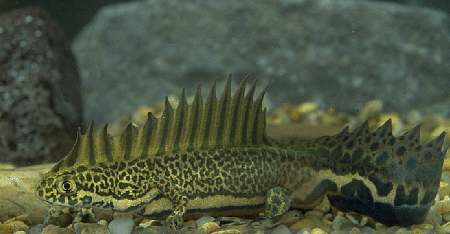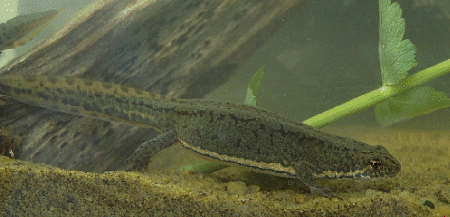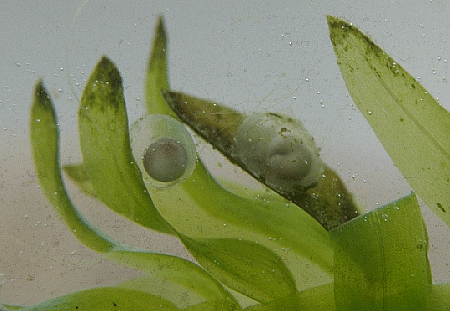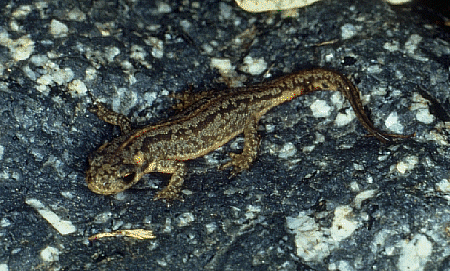
The spectacular male of the South-eastern Turkish Triturus vittatus cilicensis
from the Adana region of south east Turkey
by Marc S Staniszewski

The spectacular male of the South-eastern Turkish Triturus
vittatus cilicensis
from the Adana region of south east Turkey
Description:
The three forms are all fairly uniform in length but vary in size. This species is unusal in that mature males are often as much as 30% gretaer in length than males - something rarely seen in newts of the genus Triturus. The most robust forms are Triturus vittatus ophryticus with adult males attaining 6½ - 6¾ inches (16.51 - 17.12cm) and the south-eastern Turkish form T.v.cilicensis which reach a maximum of around 6¼ inches (12.7cm) . The nominate form T.v.vittatus attains a maximum length of 6¼ inches (15.88cm) is by far the most slender of the forms. In their terrestrial state, the main dorsal colour of all forms varies from sandy brown to light grey. Faint darkish flecking may be present particularly in females. The head is quite broad and somewhat depressed with T.v.vittatus possessing more prominent eyes (rather like those of plethodontid salamanders) than the other subspecies. This newt's common name is derived from the attractive broad pearl or cream band which extends along the flanks. During courtship this band becomes even more conspicuous as do the throat and venter which transform from a red-brown to a bright orange in T.v.ophryticus and T.v.cilicensis, and from a greyish-white to a silvery white or pale yellow in T.v.vittatus. In the latter subspecies heavy spotting is also present on the throat and to a lesser extent on the belly while in the other subspecies this is completely absent.

It is during courtship that male banded newts come into a class of its own in terms of beauty. The denticulate dorsal and tail crests that develop are the most flamboyant of all semi-aquatic newts. In T.v.ophryticus and T.v.cilicensis it extends from a point just behind the snout where it soon rises to as high as 2 inches (5.08cm) and appears like a jagged piece of silvery olive and white corrugated metal. This crest discontinues at a point just above the cloaca before recommencing along the tail. In addition the head and upper flanks develop a networked pattern of white spots interlaced with olive veins while the eyes become conspicuously surrounded by a white ring making them appear twice as large. Elsewhere, the feet and lower regions of the hind limbs are adorned in thick webbing, the venter takes on a more vivid colour and the cloacal region swells considerably. An iridescent dark blue stripe can also be discerned along the centre of the tail which may also encroach upon the cloaca. Male T.v.vittatus have a lower (0.8 - 1 inch) and less denticulate crest than its counterparts, and the wiry limbs appear almost too fragile and end in extremely long digits (8 - 15mm) with the rear limbs lacking the heavy webbing. Also, the network of spotting on the upper flanks is more highly concentrated sometimes attractively engendering an almost shimmering white appearance. Courting T.v.cilicensis males is similar to that displayed in T.v.ophryticus although webbing is usually absent from the hind limbs and the tail is less pointed and lacks the iridescent dark blue. In contrast females of all three subspecies remain comparatively dull but are overall much more robust and develop strong but low crests on the tail to aid swimming.
Captive Care
Banded newts present few difficulties in captivity because naturally they are dwellers of high altitudes (above 1500m) and are therefore tolerant of very low temperatures. Normally there are two well-defined periods of activity - from early Spring to early Summer (February to June) which forms the courtship period, and early Autumn to early Winter when they actively hunt for food. At other times they will enter a phase of torpidity, hibernating when temperatures fall below 39° F. (3.9°C.) during mid Winter or aestivating in hot, dry weather during Summer.
Housing
Above all else the container used for maintaining these newts
must be completely escape proof for they have a wonderful affinity for seeking and finding
the slightest gap through which they can squeeze by using a combination of body flattening
and slime secretions.
Indoor Terrarium
A 36inch (91.44cm) glass aquarium with a rigid, well-ventilated lid (available from most
herptile outlets) will adequately house up to eight adult newts. If located near a
well-lit but sunless window there is no requirement for supplementary lighting but where
this is necessary (for example in a dark location or where live plants are present) it
should be in the form of a low wattage, natural daylight tube. The basal substrate should
be around 4 - 8 inches (10.16 - 20.32cm) deep and split roughly into two parts: live
sphagnum moss which is kept moist but not sodden can form one part, while a mixture of dry
tree bark, twigs and leaves can form the drier part. Several robust pieces of cork bark
and limestone rocks should be settled firmly onto the basal substrate to provide seclusion
for these shy amphibians. Various plants such as small ferns, Creeping Jenny (Lysimachia)
mind-your-own-business (Helxine) and Marjoram can be grown and provide
higher humidity but need good light. In the centre of the vivarium a 10 inch
(25.4cm) wide, 2 - 4 inch (5.08 - 10.16cm) deep water pan can be provided which should
have easy access/egression points such as a suitable slanting log or stone. The sphagnum
moss part of the vivarium must be lightly misted each evening to create dew and entice the
newts out to hunt for food at night.
Normal room temperatures must not stray above 70° F. (21.1°C.) and should it be impossible to prevent such conditions arising then the newts should be allowed to aestivate by filling the vivarium with a further 10 - 15 inches (38.1cm) of a damp, chopped live sphagnum moss, moss peat and straw mixture.
Outdoor Vivarium
Banded newts make excellent subjects for outdoor vivaria mainly because of their
temperature-tolerant nature. After years of keeping this species I have come to the
conclusion that a converted greenhouse is more successful than an 'open' brick-walled
enclosure on several counts. First it is almost impossible to prevent newts escaping from
the latter and they are less tolerant of pesticide's / fungicides and pollutants than most
newts and temperate amphibians. This does not mean to say that they won't survive outdoors
but they are more at risk than if they were in a carefully sealed greenhouse. Installation
of both the greenhouse and walled enclosures are based on the same principle except that
with the greenhouse the framed glass structure completely covers the whole arrangement.
Foundations should be around 36 - 48 inches (91.44 - 121.92 cm) high and consist of either
cemented bricks/concrete breeze blocks or metal sheets, of which 24 - 36 inches (60.96 -
91.44 cm) should lie below the ground level. The whole base should then be layered with 6
inches (15.24cm) of round pebbles which are compacted with a garden roller or sledge
hammer to provide a barrier against burrowing newts but still allowing good drainage. On
top of this can be settled a 6 - 10 inch (15.24 - 25.4cm) layer of sand and then,
excepting one corner where a pond is to be located, a 12 - 15 inch (30.48 - 38.1cm) layer
of rubble (broken crocks, wood, logs and bricks) should be spread evenly to form the
hibernation / aestivation quarters. On top of these are placed a few layers of inverted
turf which not only prevent the soil which is to be situated on top from filling in the
spaces in the rubble but also gives added protection for newts resting in the rubble
against harsh weather. Gaps should be left in between turf into which clay or concrete
piping should be inserted at an angle to provide easy access to the rubble. A good layer
of insecticide-free compost should then be spread over the turf. At this point the pond
can be put in place ensuring that where a liner is used there are no sharp edges to cause
a puncture. A pond should always have gently sloping sides and in the case of Banded Newts
a fairly deep (24 - 40 inches (60.96 - 101.6cm)) central region which will remain
relatively cool even in hot weather. The rest of the greenhouse can then be furnished with
moss, plants, logs and rocks to give a Mediterranean feel and as with an indoor vivarium
it should incorporate both damp and dry areas. The actual greenhouse itself must be
inspected with a fine tooth comb and any small gaps on the vertical and lower
diagonal planes must be sealed with a weather-proof silicone sealant. Good ventilation is
essential in hot weather and therefore roof vents and fully opening the door during the
day are necessary. In the case of the latter a 3 foot high, semi-rigid , smooth perspex
sheet which fits the width of the door opening can be inserted to hinder escape and a wire
netting can be fixed over the entire door and roof vents to prevent potentially harmful
rats, birds and cats entering. Some form of shading may also be necessary. Many other
temperate amphibians and some reptiles can be kept amicably together in the same set-up
but be warned that Banded Newts are a vigorous species and when in an aquatic state they
will attack and devour tadpoles, other newts larvae and even smaller newts. A walled
enclosure can be used and is constructed in a similar manner except the foundation should
rise a further 24 - 36 inches (60.96 - 91.44cm) above the ground level. On the topmost
layer of bricks should be fixed a 10 inch (25.4cm) overhanging 'lip' consisting of roofing
tiles or perspex. Wire netting should cover the entire enclosure.
Feeding
These newts will take most small, soft-bodied invertebrates such
as earthworms, white slugs, waxworms, freshly-sloughed mealworms and caterpillars. Unlike
other newts they also display quite agile movements and may stalk crickets and flies which
they snare with a long and sticky extendable tongue. All food should be dusted liberally
with a multivitamin powder such as Repton or RepCal in captivity.
Courtship & Breeding
The main breeding period for Triturus vittatus is from
March to early July although adults may enter water before this if weather permits. There
are two factors which determine whether a newt will enter the water - first it must have
sufficient body weight from the Autumn/early Winter feeding period and secondly it must
have a had a short but definite hibernation period. The latter can be accomplished by
placing newts in an escape-proof container filled with a mixture of damp chopped sphagnum,
moss peat and straw. This is then located in a cool but frost-free location such as an
unheated garage, attic or fridge part of a refrigerator for a period of 8 - 14 weeks. On
returning the newts to their vivarium males will regularly be seen in and around the water
bowl and it is at this point they should be transferred to a large, escape-proof aquarium
filled with 18 - 36 inches of cool (45 - 65° F.), fresh water
which is freely oxygenated and filtrated. Plants such as Elodea densa, Hygrophilia,
Ludwigia mulerttii and Sagittaria are to be preferred to plants with small
foliage and need only be grown in small quantities. In the wild they often breed in
limestone rock pools devoid of vegetation. The aquarium should also be moderately lit and
the decor can consist of a gravelled base. Several large limestone and granite rocks (one
of which should protrude out of the water to give a terrestrial area) will give more
surface area Here, over a period of several weeks, males will take on their breeding
adornments and mark out small but distinct territories which they will defend vigorously
from other males and newt species. This is a trait seen in very few Triturus species and
places a limitation on the number of males which can be maintained in a single body of
water (a 36 inch (91.44cm) aquarium should have a maximum of 2 males). Females remain
terrestrial where they will consume large quantities of food but by mid-March they will
also be frequenting the water pan. On introduction to the aquarium females are initially
quite reluctant to show an interest in the males frenetic courtship display which involves
tail oscillation, head bobbing, back arching and an intense nudging or even biting of the
female. Fertilization is non-copulatory but internal and eventually possibly as long as 8
- 10 weeks later she will finally accept one or more male spermatophores (often from
several different males depending into whose territory she has entered) which she will
either store in special ducts called receptaculum seminis for later use or immediately
utilize them to fertilize her eggs.
Egg-laying

Banded newts eggs have a 1.3mm (2.3mm including gelatinous capsule) diameter and are half cream, half olive-brown coloured. Females prefer to carefully wrap each one in the leaf of a suitable plant but Elodea canadensis is rarely used because it seems to be too compact and narrow-leaved. 1cm width strips of thin plastic are also used and provide a more hygienic egg-laying site. T.v.ophryticus and T.v.cilicensis may deposit in the region of 120 - 200 eggs over a period of 3 months, while T.v.vittatus may produce as few as 60. The nominate form is also unusual in that it may simply adhere its eggs to rocks.
Care of Eggs and Larvae

A well advanced larvae of the Caucasian banded newt (Triturus vittatus
ophryticus)
requires copious amounts of Daphnia, bloodworm, tubifex and other water
invertberates
Adults will avidly consume their own eggs unless food is regularly provided. In any case eggs are best removed to an aquarium similar in terms of water quality, temperature and decoration. Hatching commences after 5 - 12 days depending on temperature and the 10 - 12mm larvae are relatively slow growing. They need large quantities of infusoria, live paramecium, daphnia, cyclops and tubifex and after 3 months should be approximately 30 - 38mm in length where they will now consume bloodworm, chopped earthworm and gnat nymphs. Metamorphosis after 4 months is a critical time when plenty of mossy, terrestrial platforms should be provided. The 3cm newtlets should be removed to ice-cream tubs filled with moss where they must be provided with suitably small, soft-bodied invertebrates. They are best overwintered in a cool room for the first winter where they will feed sparingly. If food is generously given maturity will be attained in the third year when the newts are around 3 inches (7.62cm) in length, although T.v.cilicensis may breed just two years after metamorphosis at a length of 2½ inches (6.35cm).

A recently metamorphosed Caucasian banded newt Triturus vittatus
ophryticus
has distinct patterning especially the light parotid glands and the presence
of the band on the lower flanks
References
Information gathered from the following books/persons was used in the generation of this page.
1.) Newts and Salamanders of Europe - Richard Griffiths (Poyser Natural
History)
2.) A Field Guide to the Reptiles & Amphibians of Britain & Europe -
Arnold/Burton/Ovenden - (Collins)
3.) The Tailed Amphibians of Europe - J.W.Steward (David & Charles)
4.) The Taxonomic Status of the Banded Newt (Triturus vittatus) in Southern Turkey -
Olgun, Tok, Arntzen & Turkzan (BHS Herpetological Journal Vol.7 pp. 169-171 (1997))
| 5.) Amphibians in
Captivity Marc Staniszewski (1995) (TFH) |
![[image]](../Images/tfhbook.jpg) |
All text and photo's - Copyright ©1996-9 Marc Staniszewski
Most recent revision: 30/11/99
Back to my Personal File